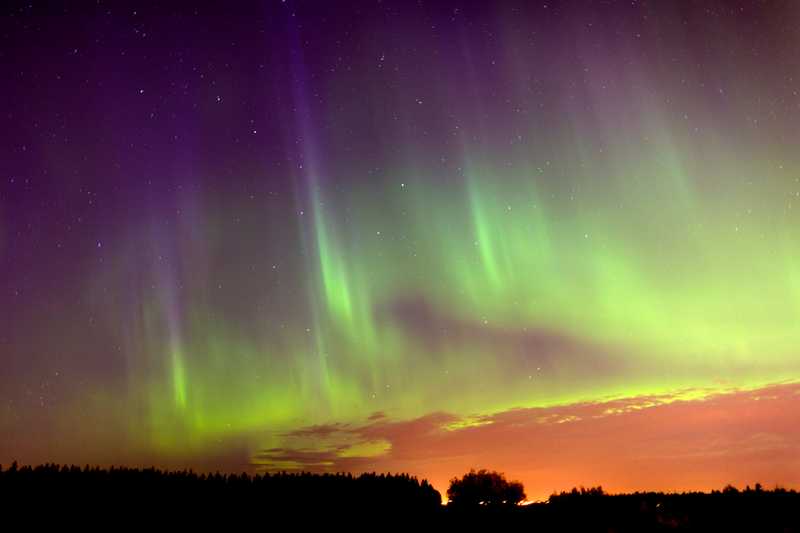
The bright dancing lights of the aurora are actually collisions between electrically charged particles from the sun that enter the earth's atmosphere. The lights are seen above the magnetic poles of the northern and southern hemispheres. They are known as 'Aurora borealis' in the north and 'Aurora australis' in the south..
Auroral displays appear in many colours although pale green and pink are the most common. Shades of red, yellow, green, blue, and violet have been reported. The lights appear in many forms from patches or scattered clouds of light to streamers, arcs, rippling curtains or shooting rays that light up the sky with an eerie glow.
Variations in colour are due to the type of gas particles that are colliding. The most common auroral color, a pale yellowishgreen, is produced by oxygen molecules located about 60 miles above the earth. Rare, all-red auroras are produced by high-altitude oxygen, at heights of up to 200 miles. Nitrogen produces blue or purplish-red aurora.
The connection between the Northern Lights and sunspot activity has been suspected since about 1880. Thanks to research conducted since the 1950's, we now know that electrons and protons from the sun are blown towards the earth on the 'solar wind'.
Because the phenomena occurs near the magnetic poles, northern lights have been seen as far south as New Orleans in the western hemisphere, while similar locations in the east never experience the mysterious lights. However the best places to watch the lights (in North America) are in the northwestern parts of Canada, including the Yukon, Nunavut, Northwest Territories and Alaska. Auroral displays can also be seen over the southern tip of Greenland and Iceland, the northern coast of Norway and over the coastal waters north of Siberia.
There are Saskatchewan tour groups and wilderness resorts which provide a front row seat for sightseeing this natural phenomenon.
The other northern lights in Saskatchewan are the star athletes at the The Knights of Columbus Indoor Games returning for its 55th year in Saskatoon. After many years of continued success, the Games continue to thrive with its skilled athletes and the participating local schools creating a exciting legacy and culture of a sporting community.
Most people who have lived in Saskatoon for a few years, have either had a family member, child or someone they know participate in the school relays or track clubs at the Games, attended the Games to support them, and have pictures to remember it. As one acquaintance said, "I've remember going to the K of C games as a kid decades ago and I still go if I can to support my kids."
Others have gone to the Games to watch the skilled local athletes of our track clubs and U OF Saskatchewan, as well as international athletes - some who are world top-10 ranked competitors. Some have gone on to the Olympics, and keep coming back. As one of the American stars said, she keeps coming back for "the atmosphere" and upbeat excitement surrounding the kids and their schools relays. Many of the participating athletes participate in group sessions with the youth at schools promoting careers and inspiring goals while also signing autographs.
For the many reasons the Games succeed, and many are glad to have them back, and thank the KNIGHTS OF COLUMBUS for their work and continued success with the GAMES. It has put Saskatoon on the map internationally.